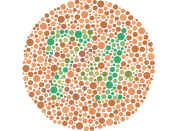Color blindness is the inability to distinguish particular colors. It is generally an inherited
trait, but can result from a chemical imbalance or eye injury.
There are three primary colors. They are red, blue, and yellow. All other colors are the
results of different combinations of primary colors. Special visual cells, called cones, are respon-
sible for our ability to see color. People with normal vision have three different types of cones,
each responsible for a different primary color.
The absence of particular cones causes the absence of particular colors. This can be one
cause of color blindness. There are four types of color blindness. The rarest forms are mono-
chromatism and a-typical monochromatism. People with monochromatic vision, or total color
blindness, has no cones at all. As a result, they have no ability to see colors, and no hue discrimination whatsoever. Monochromatic vision is very similar to watching a black and white television
program.
Somebody with a-typical monochromatic vision has just one type of cone, and can see just
one color, and various shades of that color. This form is even rarer than the 'typical' monochro-
matism.
Another, more common, form of color blindness is called dichromatism. People with di-
chromatic vision tend to confuse red, green, and gray, but can easily distinguish blue and yellow.
Some cannot even see the longest wavelengths of light -- the red end. Though it is rare, others
cannot see the short wavelengths, near the violet end. These people tend to confuse blue, yellow,
and gray, but not red and green.
Normal vision is called trichromatism. Most color blind people have a version of trichro-
matism called anomalous trichromatism. People with this condition can see the same colors as
people with normal vision, but not as well. For example, many people...


